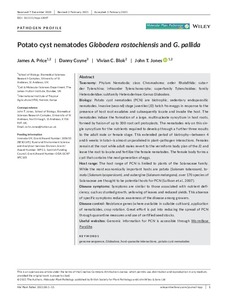| dc.contributor.author | Price, J.A. |
| dc.contributor.author | Coyne, D. |
| dc.contributor.author | Blok, V.C. |
| dc.contributor.author | Jones, J.T. |
| dc.date.accessioned | 2021-04-22T09:13:21Z |
| dc.date.available | 2021-04-22T09:13:21Z |
| dc.date.issued | 2021-05 |
| dc.identifier.citation | Price, J.A., Coyne, D., Blok, V.C. & Jones, J.T. (2021). Potato cyst nematodes Globodera rostochiensis and G. pallida. Molecular Plant Pathology, 22(5), 495-507. |
| dc.identifier.issn | 1464-6722 |
| dc.identifier.uri | https://hdl.handle.net/20.500.12478/7098 |
| dc.description.abstract | Taxonomy Phylum Nematoda; class Chromadorea; order Rhabditida; suborder Tylenchina; infraorder Tylenchomorpha; superfamily Tylenchoidea; family Heteroderidae; subfamily Heteroderinae; Genus Globodera. Biology Potato cyst nematodes (PCN) are biotrophic, sedentary endoparasitic nematodes. Invasive (second) stage juveniles (J2) hatch from eggs in response to the presence of host root exudates and subsequently locate and invade the host. The nematodes induce the formation of a large, multinucleate syncytium in host roots, formed by fusion of up to 300 root cell protoplasts. The nematodes rely on this single syncytium for the nutrients required to develop through a further three moults to the adult male or female stage. This extended period of biotrophy—between 4 and 6 weeks in total—is almost unparalleled in plant–pathogen interactions. Females remain at the root while adult males revert to the vermiform body plan of the J2 and leave the root to locate and fertilize the female nematodes. The female body forms a cyst that contains the next generation of eggs. Host range The host range of PCN is limited to plants of the Solanaceae family. While the most economically important hosts are potato (Solanum tuberosum), tomato (Solanum lycopersicum), and aubergine (Solanum melongena), over 170 species of Solanaceae are thought to be potential hosts for PCN (Sullivan et al., 2007). Disease symptoms Symptoms are similar to those associated with nutrient deficiency, such as stunted growth, yellowing of leaves and reduced yields. This absence of specific symptoms reduces awareness of the disease among growers. Disease control Resistance genes (where available in suitable cultivars), application of nematicides, crop rotation. Great effort is put into reducing the spread of PCN through quarantine measures and use of certified seed stocks. Useful websites Genomic information for PCN is accessible through WormBase ParaSite. |
| dc.description.sponsorship | Scottish Government Rural and Environmental Science |
| dc.format.extent | 495-507 |
| dc.language.iso | en |
| dc.subject | Genomes |
| dc.subject | Globodera |
| dc.subject | Potatoes |
| dc.subject | Nematodes |
| dc.subject | Host Parasite Relations |
| dc.title | Potato cyst nematodes Globodera rostochiensis and G. pallida |
| dc.type | Journal Article |
| cg.contributor.crp | Roots, Tubers and Bananas |
| cg.contributor.affiliation | University of St Andrews, United Kingdom |
| cg.contributor.affiliation | International Institute of Tropical Agriculture |
| cg.contributor.affiliation | The James Hutton Institute, United Kingdom |
| cg.coverage.hub | Eastern Africa Hub |
| cg.researchtheme | Natural Resource Management |
| cg.identifier.bibtexciteid | PRICE:2021 |
| cg.isijournal | ISI Journal |
| cg.authorship.types | CGIAR and advanced research institute |
| cg.iitasubject | Agronomy |
| cg.iitasubject | Food Security |
| cg.iitasubject | Natural Resource Management |
| cg.iitasubject | Plant Breeding |
| cg.iitasubject | Plant Diseases |
| cg.iitasubject | Plant Genetic Resources |
| cg.iitasubject | Plant Production |
| cg.journal | Molecular Plant Pathology |
| cg.notes | Published online: 11 Mar 2021 |
| cg.accessibilitystatus | Open Access |
| cg.reviewstatus | Peer Review |
| cg.usagerightslicense | Creative Commons Attribution 4.0 (CC BY 0.0) |
| cg.targetaudience | Scientists |
| cg.identifier.doi | https://dx.doi.org/10.1111/mpp.13047 |
| cg.iitaauthor.identifier | Daniel Coyne: 0000-0002-2030-6328 |
| cg.futureupdate.required | No |
| cg.identifier.issue | 5 |
| cg.identifier.volume | 22 |

